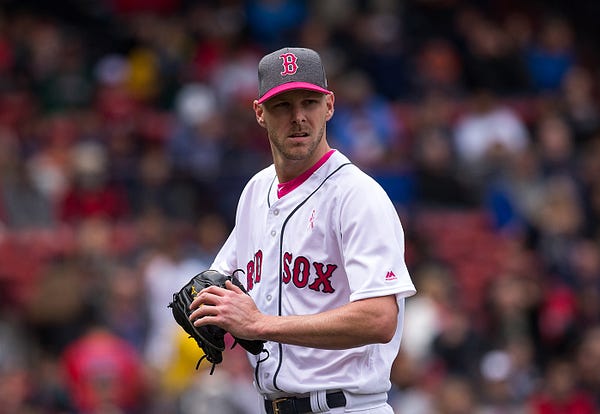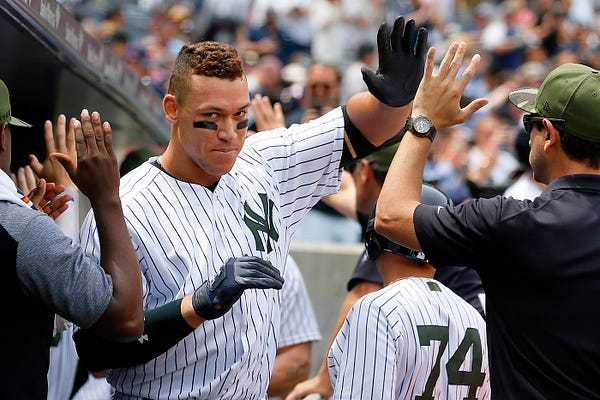After Trout – The Ringer (blog)
 You might have heard a low, baleful moaning noise across the country over the past week. Don’t be alarmed, it’s just 100 million baseball fans, wearing robes of sack cloth, marching around and chanting out of grief at Mike Trout’s busted thumb, like the monks in Monty Python and the Holy Grail.
You might have heard a low, baleful moaning noise across the country over the past week. Don’t be alarmed, it’s just 100 million baseball fans, wearing robes of sack cloth, marching around and chanting out of grief at Mike Trout’s busted thumb, like the monks in Monty Python and the Holy Grail.
However, there is one upside to Trout’s absence. From the moment his second big league stint started in 2012, he’s been the best player in baseball. There’s been no debate, which is bad, because the culture of sports relies on such debates: Low-stakes issues with no real correct answer that depend on how you look at the question and, more often than not, what your partisan interests are. You know, Mays vs. Mantle, Bird vs. Magic, Ronaldo vs. Messi.
Trout’s the best player since prime Barry Bonds and might one day become the best player ever, and in 2017 he’s been better than he’s ever been. When Trout returns in five to seven weeks, he will once again be the best player in baseball.
But for the next month and a half, there’s a power vacuum. There will be a debate over who the best player in baseball is, and the answer will once again depend on how you phrase the question. So let’s look at a few different ways to phrase the question: With Mike Trout on the shelf, who’s the best player in baseball?
Who else had a claim on the title before?
The closest there’s ever been to a debate about Trout’s supremacy — and no, I’m not counting Miguel Cabrera pilfering two MVP awards from the Millville Meteor, because that wasn’t a debate; it was the death rattle of a generation of uncurious old men as they finally realized they were too lazy to hold on to cultural hegemony — has been Trout vs. Bryce Harper.
When Trout was putting up the best age-20 season in MLB history, Harper was putting up the best age-19 season in MLB history, and since then they’ve been linked in the popular consciousness. “Who Ya Got: Trout or Harper?” has been a cottage industry all on its own since 2012, and it was a fascinating question — Harper’s power vs. Trout’s speed, Harper’s charisma vs. Trout’s understated excellence — before Trout proved himself to be the better player in the long run.
But the answer to “Trout or Harper?” gets really easy when you can’t have Trout, and since Harper’s hitting .322/.434/.639 and walking almost as much as he’s striking out, he’s within spitting distance of being the best player in baseball even with Trout in the game.
Who’s the best player in baseball? And don’t forget that pitchers are players too!

Comparing a pitcher to a position player isn’t exactly an apples-to-apples affair, but it’s not impossible, thanks to the various heuristics that tell us how good a starting pitcher with certain stats has to be in order to compare to a position player with certain stats — whether that’s WAR or just a gut feeling.
The big league leader in fWAR — even including Trout — is Red Sox left-hander Chris Sale, who’s third in the league in innings pitched, leading all qualified starters in K/9 ratio, and has the eighth-best BB/9 among qualified starters. Nobody in Boston is missing Yoan Moncada and Michael Kopech too badly at the moment.
Except, FanGraphs WAR is based on FIP, which tells you how many runs a pitcher ought to have allowed given his peripheral stats. That’s one way to look at pitcher performance, and it’s important to remember how little control a pitcher has once the ball leaves his hand, and how many of the outcomes on which he’s judged take place after that point. But to some extent, it’s also dealing in hypotheticals, and while FIP says Chris Sale’s ERA ought to be 1.83, it’s actually 2.89.
The current leader in ERA is Houston’s Dallas Keuchel at 1.67, with a FIP of 3.02. Keuchel’s a league-average strikeout-and-walk guy, more or less, but he keeps the ball on the ground better than anyone else in the game. His 3.66 GB/FB rate is by far the best in baseball, so he’s had immense success despite being more of a pitch-to-contact guy than Sale. Keuchel — and this doesn’t mean he hasn’t also been very good — has been getting a little lucky. His .222 opponent BABIP is fourth-best in baseball, which is probably a mix of good fortune and inducing weak contact. Keuchel has also stranded an MLB-high 88.7 percent of his baserunners, while Sale, at 69.8 percent, ranks 69th out of 84 qualified starters. Strand rate has to do with how good a pitcher is in general, as well as how well he pitches with men on base, but it also has to do with luck, whether he allows hits or walks one at a time or in bunches.
FIP tries to iron these things out, because a pitcher doesn’t have total control over his BABIP and strand rate, but they still matter. If you’re looking for a tiebreaker, consider WARP, the Baseball Prospectus metric based on DRA, which has the same mission as FIP but a far more sophisticated approach. Sale ranks first, with Keuchel fourth, four-tenths of a win behind him. Either way, both Keuchel and Sale have produced about as much value as Trout this season, both have a strong track record, and they’re as good a choice as any position player.
OK, so what if you pick a pitcher and you’re not trying to be too cute about it?
That’s a fair point. Clayton Kershaw is the best pitcher in baseball, even if Sale and/or Keuchel has been a little better over the past two months. He has three Cy Young awards, an MVP, three strikeout titles, four ERA titles, and he’s currently leading the National League in ERA and is second in innings pitched, so you know he isn’t slipping. If you’re picking a pitcher to replace Trout atop the pyramid, it should probably be Kershaw.
Who’s been the best player in baseball this season, aside from Trout?

Maybe Sale or Keuchel, but just looking at the numbers from 2017, there are two other obvious contenders. One is the Yankees outfielder Aaron Judge, who’s a rounding error behind Trout in bWAR. He’s leading the league in home runs, and is second, behind Trout, in wRC+. Washington first baseman Ryan Zimmerman’s been almost as good a hitter as Judge — close enough that Judge’s lead could evaporate in a day or two — but Judge is a pretty good defensive corner outfielder, while Zimmerman has been a catastrophically bad defensive first baseman, and that distinction matters. Judge, somewhat unusually for a breakout star who plays in New York, has deserved every bit of the attention he’s gotten — and hey, look, he’s now the leading AL vote-getter for the All-Star Game — because a third of the way through his first full season in the majors, he’s been the best non-Trout hitter in the game.
But Judge is actually tied for second in bWAR, with Reds shortstop Zack Cozart. If you had a good defensive shortstop who hit .353/.439/.626, you’d expect him to be the best player in baseball or close to it. It’s not surprising that a player with Cozart’s numbers is topping WAR leaderboards, but it’s incredibly surprising that Cozart has those numbers.
I try not to freak out about small-sample outliers, which sometimes makes me really slow to change an initial impression of a player. I’m reluctant to give up on prospects, and I was late to the party on guys like Keuchel and Atlanta first baseman Freddie Freeman when they took the leap. Cozart, who’s been the Reds’ starting shortstop since 2012, never challenged that first impression until now: He’s always been a good defender but never a good hitter. In Cozart’s first three full seasons, he hit .241/.280/.362. He hit well in an injury-shortened 2015 season, and in 2016, he hit .252/.308/.425, breaking the .300 OBP and .400 SLG barriers for the first time, all of which was still only good enough for a meager OPS+ of 91. And to be honest, that looked like Cozart’s one-year hot streak. Only this year, Cozart’s walking almost three times as often as his career average (14.0 percent, up from 5.3 percent) and beating his previous career full-season highs in OBP by 131 points and SLG by 201 points, all on a batted-ball profile that looks almost identical to the one he put up in 2016. Inconceivable as all that is, those numbers are in the bank: He’s actually been the best player in the National League this year, whether you believe it or not.
So, suffice it to say, I (clap emoji) have (clap emoji) no (clap emoji) idea (clap emoji) how (clap emoji) Zack (clap emoji) Cozart (clap emoji) is (clap emoji) doing (clap emoji) this. Looking at Cozart’s BABIP (.399, up from last year’s .274) or how his wOBA compares to xwOBA (second-worst in baseball, insofar as we can trust the brand-new proprietary Statcast metrics at this point in their evolution) and it feels like a fluke. But it’s such a big fluke that even calling it a fluke isn’t that comforting. Cozart’s season is shaking the fabric of what I believed to be the natural order of things, and it terrifies me.
If you’re picking a player to start your franchise with, and you can’t pick Trout, who’s the best player in baseball?
This is a slightly different question than “best player in baseball” because it adds an element of future projection — how long will that player be good? Can he improve? If you want to, you could add off-the-field components, too: How much longer is he under team control, and for what cost? Is he fun to watch and easy to root for?
Harper would be a good choice here, as would Kershaw, Kris Bryant, Corey Seager, or Carlos Correa, whom Jonathan Bernhardt of FanRag Sports wrote about on Tuesday with this very question in mind. I wouldn’t reject an argument for José Altuve out of hand, either.
But if I were starting a team right now and could pick one non-Trout player to build around, I’d take Francisco Lindor. He is already as good an all-around player as anyone else I’ve mentioned except Kershaw, who’s a pitcher and six years older, and Harper, who doesn’t play a more valuable up-the-middle position. Lindor is already one of the best defensive shortstops in baseball, and unlike Correa and Seager, he’s a lock to stay there long-term. At age 23, Lindor’s bat is still developing — he’s hitting for more power than ever this year at the cost of a near-40-point drop in batting average, but if he could ever figure out how to do both at the same time, he’d be a near-Troutlike player. Even if he doesn’t — Melvin Upton is a notable example of a young player who could hit for average and power, just not at the same time — he’s still one of the best players in the American League.
Meanwhile, Lindor is bilingual, exciting to watch, enthusiastic, and fit in perfectly as the face of a team on which he’s the youngest player, all with no public friction with the club’s veterans. He’s a guy you can build around.
Who’s the most Troutlike player in baseball?
What makes Trout so great is the number of things he does well. He hits for average and power, he gets on base, he plays an up-the-middle position, he steals bases when he wants to, and he’s completely studiously noncontroversial. There just isn’t a poor man’s version of that in center field. George Springer doesn’t hit for a high enough average and he stopped stealing bases. Charlie Blackmon doesn’t walk enough and has a distinctly un-Troutlike beard.
Expand it to up-the-middle players and it’s still tough. Lindor doesn’t have the power, Seager and Correa don’t have the speed, and Altuve, coming off a season where he hit 24 home runs to go with 30 stolen bases and a .396 OBP, is too much fun.
The answer is a former MVP who, like the Trout of catchers, has been so obviously the best at his position we’ve taken him for granted: G.D. “Buster” Posey. As of Tuesday morning, it’s Posey who ranks third to Trout in OBP, and as a catcher, where the offensive standards are even lower than they are in center field. Posey’s slugging .509 with 25 walks against only 17 strikeouts, and is one of the best defenders in the league at his position. He might not be the second-best player in the game, but he comes the closest to capturing the essence of Trout: Guileless excellence.





